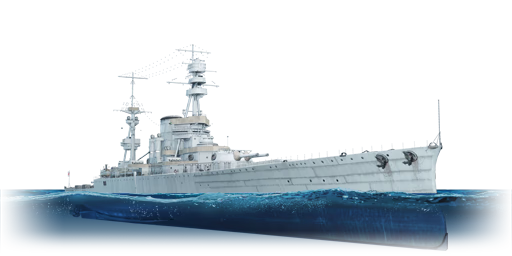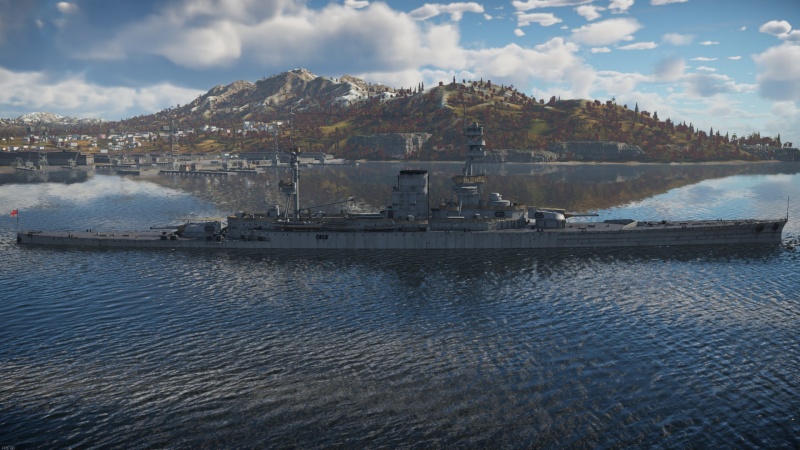Difference between revisions of "HMS Glorious"
(→Usage in battles: Merged previous, edits) |
(Added template) |
||
| Line 123: | Line 123: | ||
* [[wt:en/news/7920-development-hms-glorious-an-outrageous-warship-design-en|[Devblog] HMS Glorious: An Outrageous Warship Design]] | * [[wt:en/news/7920-development-hms-glorious-an-outrageous-warship-design-en|[Devblog] HMS Glorious: An Outrageous Warship Design]] | ||
| + | {{ShipManufacturer Harland and Wolff}} | ||
{{Britain battlecruisers}} | {{Britain battlecruisers}} | ||
Revision as of 16:14, 19 August 2023
Contents
Description
One of the trio of the Courageous-class "large light cruisers", the HMS Glorious's design perfectly encapsulates First Sea Lord John ('Jackie') Fisher's obsession with superior speed and firepower. Built with his 'Baltic Project' in mind, the ship was designed with high speed and large guns to devastate enemy cruisers while having a shallow draught to allow operations supporting coastal landings in the Baltics. Despite being a capital ship, it was designed with paper thin armour, partly to allow for the high speed and partly to get around a restriction imposed by the Government on the construction of new capital ships, with First Sea Lord Fisher presenting the ships as simply large light cruisers. In fact, the ships were so lightly built that HMS Courageous took not insignificant structural damage in rough seas during sea trials, buckling the hull and deck in several places, shearing off rivets and allowing water to pour in.
Introduced in Update "Fire and Ice", the unconventional design of HMS Glorious in her 1919 configuration makes her very distinctive from the other "pocket battleships" at her BR, such as Graf Spee and the Ikoma. The ship is a true "glass cannon", featuring high offensive firepower in the form of four 381 mm cannons, numerous 102 mm guns, a huge stockpile of torpedoes, along with great mobility to boot, however still lacks adequate armour to shield from even cruiser-calibre guns.
General info
Survivability and armour
Talk about the vehicle's armour. Note the most well-defended and most vulnerable zones, e.g. the ammo magazine. Evaluate the composition of components and assemblies responsible for movement and manoeuvrability. Evaluate the survivability of the primary and secondary armaments separately. Don't forget to mention the size of the crew, which plays an important role in fleet mechanics. Save tips on preserving survivability for the "Usage in battles" section. If necessary, use a graphical template to show the most well-protected or most vulnerable points in the armour.
Mobility
Write about the ship's mobility. Evaluate its power and manoeuvrability, rudder rerouting speed, stopping speed at full tilt, with its maximum forward and reverse speed.
| Mobility Characteristics | |||
|---|---|---|---|
| Game Mode | Upgrade Status | Maximum Speed (km/h) | |
| Forward | Reverse | ||
| AB | |||
| Upgraded | |||
| RB/SB | |||
| Upgraded | |||
Modifications and economy
Armament
Primary armament
Provide information about the characteristics of the primary armament. Evaluate their efficacy in battle based on their reload speed, ballistics and the capacity of their shells. Add a link to the main article about the weapon: {{main|Weapon name (calibre)}}. Broadly describe the ammunition available for the primary armament, and provide recommendations on how to use it and which ammunition to choose.
| Penetration statistics | |||||||
|---|---|---|---|---|---|---|---|
| Ammunition | Type of warhead |
Penetration @ 0° Angle of Attack (mm) | |||||
| 1,000 m | 2,500 m | 5,000 m | 7,500 m | 10,000 m | 15,000 m | ||
| 4crh CPC | SAPCBC | 487 | 462 | 427 | 399 | 377 | 345 |
| 4crh Mark XIIa APC | APCBC | 644 | 597 | 528 | 470 | 422 | 357 |
| Shell details | ||||||||||||
|---|---|---|---|---|---|---|---|---|---|---|---|---|
| Ammunition | Type of warhead |
Velocity (m/s) |
Projectile mass (kg) |
Fuse delay (s) |
Fuse sensitivity (mm) |
Explosive mass (TNT equivalent) (kg) |
Ricochet | |||||
| 0% | 50% | 100% | ||||||||||
| 4crh CPC | SAPCBC | 752 | 871 | 0.035 | 26 | 58.6 | 48° | 63° | 71° | |||
| 4crh Mark XIIa APC | APCBC | 752 | 871 | 0.025 | 26 | 20.68 | 48° | 63° | 71° | |||
Secondary armament
Some ships are fitted with weapons of various calibres. Secondary armaments are defined as weapons chosen with the control Select secondary weapon. Evaluate the secondary armaments and give advice on how to use them. Describe the ammunition available for the secondary armament. Provide recommendations on how to use them and which ammunition to choose. Remember that any anti-air armament, even heavy calibre weapons, belong in the next section. If there is no secondary armament, remove this section.
| Penetration statistics | |||||||
|---|---|---|---|---|---|---|---|
| Ammunition | Type of warhead |
Penetration @ 0° Angle of Attack (mm) | |||||
| 1,000 m | 2,500 m | 5,000 m | 7,500 m | 10,000 m | 15,000 m | ||
| 4 inch HE | HE | 11 | 11 | 11 | 11 | 11 | 11 |
| 4 inch SAP | SAP | 90 | 72 | 51 | 37 | 28 | 24 |
| Shell details | ||||||||||||
|---|---|---|---|---|---|---|---|---|---|---|---|---|
| Ammunition | Type of warhead |
Velocity (m/s) |
Projectile mass (kg) |
Fuse delay (s) |
Fuse sensitivity (mm) |
Explosive mass (TNT equivalent) (g) |
Ricochet | |||||
| 0% | 50% | 100% | ||||||||||
| 4 inch HE | HE | 805 | 14.06 | 0 | 0.1 | 721 | 79° | 80° | 81° | |||
| 4 inch SAP | SAP | 805 | 15.2 | 0.015 | 5 | 520 | 47° | 60° | 65° | |||
Anti-aircraft armament
An important part of the ship's armament responsible for air defence. Anti-aircraft armament is defined by the weapon chosen with the control Select anti-aircraft weapons. Talk about the ship's anti-air cannons and machine guns, the number of guns and their positions, their effective range, and about their overall effectiveness – including against surface targets. If there are no anti-aircraft armaments, remove this section.
Additional armament
Describe the available additional armaments of the ship: depth charges, mines, torpedoes. Talk about their positions, available ammunition and launch features such as dead zones of torpedoes. If there is no additional armament, remove this section.
Usage in battles
HMS Glorious is a classic "glass cannon", featuring extremely powerful 381 mm cannons, backed up by a suite of decent secondary armaments and torpedoes, and great mobility. However, it also has extremely thin armour, which can sometimes prove insufficient against even cruiser-calibre cannons.
Against other battleships and battlecruisers, the armour is wholly inadequate, and the ship really does become equivalent to a large light cruiser. Its mobility can be used to play around hard cover and attempt to dodge incoming shells; however, if caught in the open, Glorious is unlikely to survive for long.
On the other hand, if in a match against only cruisers, the unusual armaments can be used to great effect, quickly destroying any cruiser in a few good hits. When facing destroyers, consider switching to control of the 102 mm cannons - the greater volume of fire (up to 12 guns on a broadside) and sufficient stopping power of the guns will rapidly wreck any small ship. The 4" SAP ammunition is significantly better for this than the stock HE.
Pros and cons
Pros:
- Four 381 mm guns, enough to cripple any enemy it might have to face
- Numerous fast-firing 102 mm provides steady damage output at mid-to-close range
- Huge empty space at the bow and stern can absorb several hits from shells and torpedoes
- Quite fast and manoeuvrable, despite the size
- Equipped with 40 torpedoes with decent performance
Cons:
- Very large and distinctive hull shape, easily identified and hit by any enemies
- Poor armour protection, relies heavily on fuel tanks to absorb damage
- Terrible main turret traverse speed, inability to fire reactively
- Poor anti-air defence
- Fixed torpedo tubes restrict their usage to saturational barrages
History
The Courageous-class battlecruisers were formulated during WW1 by the ever-eccentric First Sea Lord, Jacky Fisher, as part of his 'Baltic Project', a planned attack on the German Baltic coastline. In 1915, the Chancellor of the Exchequer had forbidden new construction of any warships larger than light cruisers, yet Lord Fisher wanted new fast capital ships for the Baltic Project in order to support his proposed landings of troops on the beaches of Pomerania.
In order to get around the rule against new capital ships and also because of Lord Fisher's obsession with speed at the expense of all else, the Courageous class were presented as 'large light cruisers', with extremely light armour, extremely high speed and half the main armament of the new Queen Elizabeth-class battleships. Fortunately for Fisher, many of the politicians up top had little knowledge in naval matters and so they saw the high speed, low armour and just approved the design for construction. Unfortunately, however, the ships proved to be a little too lightly built and had a tendency to take structural damage in rough seas or at high speed or even when firing the main guns until they were structurally stiffened in response.
As Fisher's Baltic Project never took place, the ships spent the war patrolling the North Sea. HMS Glorious saw little action, other than the Second Battle of Heligoland Bight, during which she only suffered damage from a premature shell detonation and her own muzzle blasts. She was also present for the surrender of the German High Seas Fleet in 1918.
Following the end of WW1, the battlecruisers were converted into aircraft carriers due to their high speed, whilst the 381 mm turrets of Courageous and Glorious were put into storage. During WW2, these turrets would be reused in the construction of HMS Vanguard, the last battleship ever built.
During WW2, Glorious served in the Mediterranean, Indian Ocean, and in the Norwegian Campaign, before being intercepted in the Norwegian Sea by Scharnhorst and Gneisenau. Due to a number of faults in leadership, the ship was flying no patrols and made no effort to change course or speed. Glorious was struck by Scharnhorst at a range of 24 km, the longest range capital ship hit in history (a title which Scharnhorst shares with HMS Warspite, which struck an Italian battleship at approximately the same range). Despite the heroic efforts of her two escorting destroyers, Ardent and Acasta, Glorious was sunk by the German battleships a little over two hours after first sighting them, although Scharnhorst was badly damaged by a torpedo from Acasta, requiring the ship to head to port for immediate repairs.
Media
- Skins
See also
Links to articles on the War Thunder Wiki that you think will be useful for the reader, for example:
- reference to the series of the ship;
- links to approximate analogues of other nations and research trees.
External links
| Harland & Wolff | |
|---|---|
| Frigates | |
| Whitby-class | HMS Blackpool |
| Light Cruisers | |
| Town-class | HMS Belfast |
| Battlecruisers | |
| Courageous-class | HMS Glorious |
| Britain battlecruisers | |
|---|---|
| Invincible-class | HMS Invincible |
| HMS Queen Mary* | |
| Renown-class | HMS Renown · HMS Repulse |
| Courageous-class | HMS Glorious |
| Admiral-class | HMS Hood |
| * Unique ship | |





